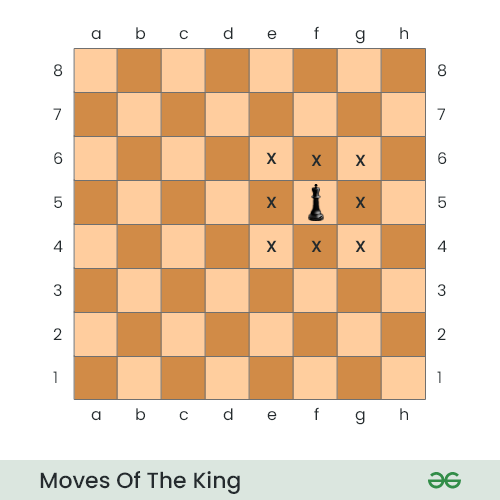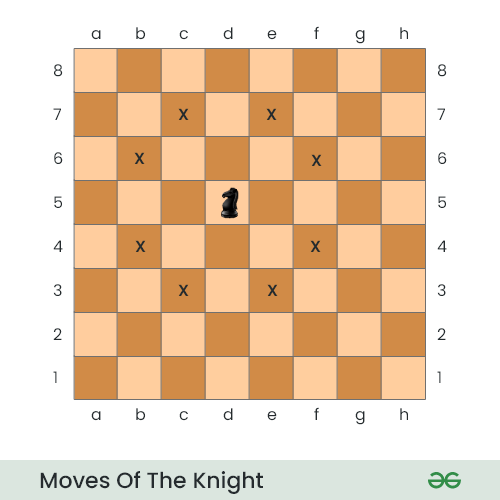Introduction to Chess | Learn Chess Online
Last Updated :
12 Jan, 2024
Chess is a timeless and strategic two-player board game that has been played for centuries. It’s a game of skill, tactics, and strategy that requires players to out-think their opponent while considering multiple possibilities at every turn. Chess is often referred to as the “game of kings” due to its historical association with royalty and the deep intellectual challenges it offers.
The origins of modern day Chess can be traced back to ancient India, where a game called chaturanga was played as early as the 6th century.
Below is the image of the initial position of a chess board, here one player plays with white pieces and the other one plays with black pieces.

The game is played on an 8×8 grid, known as a chessboard, with alternating light and dark squares. Each player controls an army of 16 pieces: one king, one queen, two rooks, two knights, two bishops, and eight pawns. Player with the white pieces starts the game and both players move alternatively.
The objective of chess is to checkmate your opponent’s king, which means putting their king in a position where it is under attack and cannot escape capture on the next move.
Chessboard Notation:
A standard chessboard has 8 rows and 8 columns, in which every cell can be pointed out using a unique notation, where:
- Rows: every row is denoted in numeric form from 1 to 8
- Columns: every column is denoted in alphabetical form like a , b , c . . . , h.
A particular cell is represented as column name followed by row name, such as a8, b4, etc.
Example 1: Here this column is called as b4 because here column is b and row number is 4.
.png)
Chessboard Notation Example
Example 2: Similarly this cell is called e5 because column is e and row number is 5 .
.png)
Chessboard Notation Example
Chess Pieces in Standard Chess Sets:
The game of chess has total 6 different kind of pieces .
1. King:
- King is the most valuable piece.
- It can move one square in any direction.
- In the following image our king is on f5 square and it can move all its neighbour cells denoted as X .
- Initially both side has one king on their side.

2. Queen:
- It is the most powerful piece on the chess board.
- It can move diagonally, vertically, and horizontally across the board.
- Both side has one queen on their sides.
- In the following image our queen is on d4 square and it can move to the any cell in one move which is represented as ‘X‘ .
.png)
3. Rook:
- Rooks moves vertically or horizontally across the board.
- Both sides play with 2 rooks on their sides.
- In the following image our rook is on d5 and it can move to any of the cells represented as ‘X‘ in one move .

4. Knight:
- Knights are the most complicated piece in the chess board.
- Both sides have 2 Knights in their side.
- It moves in an L-shape pattern: Two squares in one direction (horizontally or vertically) and then one square perpendicular to that.
- In the following image our knight is on d4 cell and it can move to any of the cells represented as ‘X‘ in one move .

5. Bishop:
- Bishop is the piece which moves diagonally in the board .
- Both sides have two different bishops .
- one can move diagonally only on the light squares.
- second one can move only dark squares.
- In the following image we have a bishop on d4 cell and it can move to any of the cells represented as ‘X‘ in one move .

6. Pawn:
- There are 8 pawns on each sides .
- Pawn moves forward one square, but captures diagonally.
- In the following image our pawn is on cell e2 and it can move to cell e3 and it can attack diagonally .
.png)
- On its first move, a pawn can advance two squares also. like in the above image it can move to cell e4 also on first move.
- Pawn is the only piece which can be promoted to any other piece if they reach the opposite side of the board.
Special Terminologies in the game of Chess:
1. Check:
Check is a condition that occurs when a player’s king is under threat of capture on the opponent’s next turn.
2. Checkmate:
It happens when king is in a position where it is under attack and cannot escape capture on the next move.
3. Stalemate:
It happens when king is in a position where it is not under attack and also it cannot move any of its pieces. In that condition game is declared as a draw.
Rules of Modern Chess Game
The rules of chess are relatively simple, but they can take some time to master. Here is a brief overview of how the game is played:
- 8×8 board: The game is played on a board that is divided into 64 squares of alternating colors (usually white and black). The board is placed so that each player has a white square in the bottom right corner.
- Starting Configuration: Each player starts with 16 pieces: one king, one queen, two rooks, two knights, two bishops, and eight pawns. The pieces are placed in a specific starting position at the beginning of the game.
- Objective: To checkmate the opponent’s king, which means to put the king in a position where it cannot escape capture.
- Moves:
- Pawns move forward one square but capture diagonally. They also have the option to move forward two squares on their first move.
- Rooks can move any number of squares horizontally or vertically.
- Knights move in an L-shape, two squares in one direction and then one square perpendicular to that direction.
- Bishops can move any number of squares diagonally.
- The queen can move any number of squares horizontally, vertically, or diagonally.
- The king can move one square in any direction.
- Special Moves: There are also special moves in chess such as “ en passant ” and “ castling ” which are used to add more strategic depth to the game.
- Flow of the game: The game is turn-based, with each player making one move per turn. The player with the white pieces moves first.
- Check: When a player puts the opponent’s king in “ check ”, the opponent’s king is in danger and the opponent has to get out of check in their next move.
- Checkmate: When a player puts the opponent’s king in “ checkmate ” , the game is over, and the player who put the king in checkmate wins.
- Draw: If neither player can checkmate the other, the game is a draw. The game can also end in a Draw if “ stalemate ” occurs i.e. neither player can make a legal move.
Note: These are the basic rules of chess, and there are variations and additional rules that apply in certain situations. It’s advisable to read a more detailed rulebook or look for a chess coach to master the game.
Special Moves in the game of Chess:
En passant: Pawns also have a unique “en passant” capture rule. In this rule if opponent pawn moves 2 squares and you have a pawn on immediate left or right side of the cell then you can capture their pawn and move diagonally.

Castling:
- It is a move in chess in which we move the king two squares toward a rook on the same rank and then moving the rook to the square that the king passed over.
- Castling is permitted only if neither the king nor the rook has previously moved also the squares between the king and the rook are vacant and the king does not leave, cross over, or finish on a square attacked by an enemy pieces. Castling is the only move in chess in which two pieces are moved at once.

Share your thoughts in the comments
Please Login to comment...